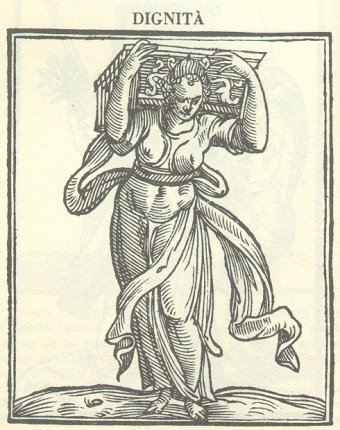|
Respect
Respect, also called esteem, is a positive feeling or action shown towards someone or something considered important or held in high esteem or regard. It conveys a sense of admiration for good or valuable qualities. It is also the process of honoring someone by exhibiting care, concern, or consideration for their needs or feelings. Some people may earn the respect of individuals by assisting others or by playing important social roles. In many cultures, individuals are considered to be worthy of respect until they prove otherwise. Courtesies that show respect may include simple words and phrases like "Thank you" in the West or "'' Namaste''" in the Indian subcontinent, or simple physical signs like a slight bow, a smile, direct eye contact, or a simple handshake; however, those acts may have very different interpretations, depending on the cultural context. Signs and other ways of showing respect Language Respect is a feeling of deep admiration for someone or someth ... [...More Info...] [...Related Items...] OR: [Wikipedia] [Google] [Baidu] |
Filial Piety
In Confucianism, Chinese Buddhism, and Daoist ethics, filial piety (, ''xiào'') (Latin: pietas) is a virtue of respect for one's parents, elders, and ancestors. The Confucian '' Classic of Filial Piety'', thought to be written around the late Warring States- Qin- Han period, has historically been the authoritative source on the Confucian tenet of filial piety. The book—a purported dialogue between Confucius and his student Zengzi—is about how to set up a good society using the principle of filial piety. Filial piety is central to Confucian role ethics. In more general terms, filial piety means to be good to one's parents; to take care of one's parents; to engage in good conduct, not just towards parents but also outside the home so as to bring a good name to one's parents and ancestors; to show love, respect, and support; to display courtesy; to ensure male heirs; to uphold fraternity among brothers; to wisely advise one's parents, including dissuading them from moral un ... [...More Info...] [...Related Items...] OR: [Wikipedia] [Google] [Baidu] |
Honorific
An honorific is a title that conveys esteem, courtesy, or respect for position or rank when used in addressing or referring to a person. Sometimes, the term "honorific" is used in a more specific sense to refer to an honorary academic title. It is also often conflated Conflation is the merging of two or more sets of information, texts, ideas, opinions, etc., into one, often in error. Conflation is often misunderstood. It originally meant to fuse or blend, but has since come to mean the same as equate, treati ... with systems of honorific speech in linguistics, which are grammatical or morphology (linguistics), morphological ways of encoding the relative social status of speakers. Honorifics can be used as prefixes or suffixes depending on the appropriate occasion and presentation in accordance with Style (form of address), style and Convention (norm), customs. Typically, honorifics are used as a Style (manner of address), style in the grammatical third Grammatical person, p ... [...More Info...] [...Related Items...] OR: [Wikipedia] [Google] [Baidu] |
Dignity
Dignity is the right of a person to be valued and respected for their own sake, and to be treated ethically. It is of significance in morality, ethics, law and politics as an extension of the Enlightenment-era concepts of inherent, inalienable rights. The term may also be used to describe personal conduct, as in "behaving with dignity". Etymology The English word "dignity", attested from the early 13th century, comes from Latin ''dignitas'' (worthiness) by way of French ''dignité''. Modern use English-speakers often use the word "dignity" in proscriptive and cautionary ways: for example, in politics it can be used to critique the treatment of oppressed and vulnerable groups and peoples, but it has also been applied to cultures and sub-cultures, to religious beliefs and ideals, and even to animals used for food or research. "Dignity" also has descriptive meanings pertaining to the ''worth'' of human beings. In general, the term has various functions and meanings depe ... [...More Info...] [...Related Items...] OR: [Wikipedia] [Google] [Baidu] |
Etiquette In Asia
Etiquette in Asia varies from country to country even though certain actions may seem to be common. No article on the rules of etiquette, nor any list of faux pas, can ever be complete. As the perception of behaviors and actions vary, intercultural competence is essential. A lack of knowledge about the customs and expectations of Asian people can make even those with good intentions seem rude, foolish, and disrespectful. Asian etiquette is often manifested with shades of "respect", "good manners" and "filial", and is highly influenced by Chinese culture. Bangladesh Bangladeshi society is reserved and very structured. While the norms change or vary, there are timeless customs such as respect for the elders and high regard for family. Old people are always treated with deference and it is considered rude for a young person to be direct and opinionated when talking to elders. Even prolonged eye contact with a senior is considered bad manners. Bangladeshis are modest peopl ... [...More Info...] [...Related Items...] OR: [Wikipedia] [Google] [Baidu] |
Bowing
Bowing (also called stooping) is the act of lowering the torso and head as a social gesture in direction to another person or symbol. It is most prominent in Asian cultures but it is also typical of nobility and aristocracy in many European countries. It is also used in religious contexts, as a form of worship or veneration. Sometimes the gesture may be limited to lowering the head such as in Indonesia, and in many cultures several degrees of the lowness of the bow are distinguished and regarded as appropriate for different circumstances. It is especially prominent in Nepal, India, Thailand, Laos, Vietnam, China, Korea, and Japan, where it may be executed standing or kneeling. Some bows are performed equally by two or more people while others are unequal – the person bowed to either does not bow in return or performs a less low bow in response. A nod of the head may be regarded as the minimal form of bow; forms of kneeling, genuflection, or prostration which involves the ... [...More Info...] [...Related Items...] OR: [Wikipedia] [Google] [Baidu] |
Pranāma
''Pranāma'' (Sanskrit: प्रणाम, praṇāma, "obeisance, prostration or bowing forward") is a form of respectful or reverential salutation (or reverential bowing) before something or another person – usually one's elders, spouse or teachers – as well as anyone deeply respected such as a deity, found in Indian culture and Hindu traditions. The gesture, also known as the apology hand gesture, is also used as an apology in certain situations. Etymology ''Pranama'' is derived from ''pra'' (Sanskrit: प्र) and ''ānama'' (Sanskrit: आनम); ''pra'' as prefix means "forward, in front, before, very, or very much", while ''ānama'' means "bending or stretching". Combined ''pranama'' means "bending, bowing in front" or "bending much" or "prostration". In cultural terms, it means "respectful salutation" or "reverential bowing" before another, usually elders or teachers or someone deeply respected such as a deity. Customs It is found in Indian culture and Hindu trad ... [...More Info...] [...Related Items...] OR: [Wikipedia] [Google] [Baidu] |
Kowtowing
A kowtow is the act of deep respect shown by prostration, that is, kneeling and bowing so low as to have one's head touching the ground. In Sinospheric culture, the kowtow is the highest sign of reverence. It was widely used to show reverence for one's elders, superiors, and especially the Emperor of China, as well as for religious and cultural objects of worship. In modern times, usage of the kowtow has been reduced. Terminology An alternative Chinese term is ''ketou''; however, the meaning is somewhat altered: ''kou'' () has the general meaning of ''knock'', whereas ''ke'' () has the general meaning of "touch upon (a surface)", ''tou'' () meaning head. The date of this custom's origin is probably sometime during the Spring and Autumn period or the Warring States period of China's history (771–221 BC), because it was a custom by the time of the Qin dynasty (221 BC – 206 BC). Traditional usage In Imperial Chinese protocol, the kowtow was performed before the Emperor of C ... [...More Info...] [...Related Items...] OR: [Wikipedia] [Google] [Baidu] |
Eye Contact
Eye contact occurs when two people look at each other's eyes at the same time. In humans, eye contact is a form of nonverbal communication and can have a large influence on social behavior. Coined in the early to mid-1960s, the term came from the West to often define the act as a meaningful and important sign of confidence and respect. The customs, meaning, and significance of eye contact can vary greatly between societies, neurotypes, and religions. The study of eye contact is sometimes known as '' oculesics''. Social meanings Eye contact and facial expressions provide important social and emotional information. People, perhaps without consciously doing so, search other's eyes and faces for positive or negative mood signs. In some contexts, the meeting of eyes arouses strong emotions. Eye contact provides some of the strongest emotions during a social conversation. This primarily is because it provides details on emotions and intentions. In a group, if eye contact is not i ... [...More Info...] [...Related Items...] OR: [Wikipedia] [Google] [Baidu] |
Handshake
A handshake is a globally widespread, brief greeting or parting tradition in which two people grasp one of each other's like hands, in most cases accompanied by a brief up-and-down movement of the grasped hands. Customs surrounding handshakes are specific to cultures. Different cultures may be more or less likely to shake hands, or there may be different customs about how or when to shake hands.Fist bump can pound out flu transmission __TOC__ History The handshake may have originated in prehistory as a demonstration of peaceful intent, since it shows that the hand holds no weapon. Another possibility is that it originated as a symbolic gesture of mutual commitment to an oath or promise: two hands clasping each other represents the sealing of ...[...More Info...] [...Related Items...] OR: [Wikipedia] [Google] [Baidu] |
Indigenous Peoples Of The Americas
The Indigenous peoples of the Americas are the inhabitants of the Americas before the arrival of the European settlers in the 15th century, and the ethnic groups who now identify themselves with those peoples. Many Indigenous peoples of the Americas were traditionally hunter-gatherers and many, especially in the Amazon basin, still are, but many groups practiced aquaculture and agriculture. While some societies depended heavily on agriculture, others practiced a mix of farming, hunting, and gathering. In some regions, the Indigenous peoples created monumental architecture, large-scale organized cities, city-states, chiefdoms, states, Realm, kingdoms, republics, Confederation, confederacies, and empires. Some had varying degrees of knowledge of engineering, architecture, mathematics, astronomy, writing, physics, medicine, planting and irrigation, geology, mining, metallurgy, sculpture, and gold smithing. Many parts of the Americas are still populated by Indigenous peoples; ... [...More Info...] [...Related Items...] OR: [Wikipedia] [Google] [Baidu] |
Lakshmi
Lakshmi (; , sometimes spelled Laxmi, ), also known as Shri (, ), is one of the principal goddesses in Hinduism. She is the goddess of wealth, fortune, power, beauty, fertility and prosperity, and associated with ''Maya'' ("Illusion"). Along with Parvati and Saraswati, she forms the Tridevi of Hindu goddesses. Within the goddess-oriented Shaktism, Lakshmi is venerated as the prosperity aspect of the Mother goddess. Lakshmi is both the consort and the divine energy ('' shakti'') of the Hindu god Vishnu, the Supreme Being of Vaishnavism; she is also the Supreme Goddess in the sect and assists Vishnu to create, protect, and transform the universe. She is an especially prominent figure in Sri Vaishnavism, in which devotion to Lakshmi is deemed to be crucial to reach Vishnu. Whenever Vishnu descended on the earth as an avatar, Lakshmi accompanied him as consort, for example, as Sita and Radha or Rukmini as consorts of Vishnu's avatars Rama and Krishna, respectively. T ... [...More Info...] [...Related Items...] OR: [Wikipedia] [Google] [Baidu] |
Western World
The Western world, also known as the West, primarily refers to the various nations and states in the regions of Europe, North America, and Oceania.Western Civilization Our Tradition; James Kurth; accessed 30 August 2011 The Western world is also known as the (from the word ''occidēns'' "setting down, sunset, west") in contrast to the known as the [...More Info...] [...Related Items...] OR: [Wikipedia] [Google] [Baidu] |




.jpg)


_02.jpg)

_2007.jpg)
